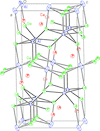issue contents
February 2021 issue

Cover illustration: Seven complexes of four pyridine/dimine ligands having two flexible alcohol arms have been prepared and their structures determined. The complexes were found to catalyze the catalytic dismutation of both peroxide and superoxide, and only show catalase-like activity in the presence of a base. The complexes with coordinated water or chloride at the axial positions show higher superoxide dismutase activity than those with coordinated thiocyanate ligands. See McKee & Kose [Acta Cryst. (2021), C77, 100-110].
research papers








![[R_{2}^{2}]](/c/issues/2021/02/00/cu3167/teximages/cu3167fi1.gif) (8) hydrogen-bonded ring, with an interplanar angle of 28.89 (8)°.
(8) hydrogen-bonded ring, with an interplanar angle of 28.89 (8)°.









 journal menu
journal menu

























